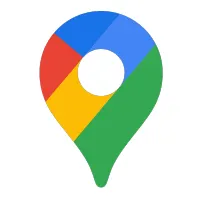Best Map Apps for China - What Actually Works
Need to get around China??Local apps (Baidu/Amap)?offer the most accurate, real-time info and complete functions. The only bad thing is the?limited English support, but you can just copy-paste Chinese addresses and know basic icons even without reading Chinese.
If you prefer sticking to English,?MetroMan + Organic Maps?work well, and?Apple Maps?is decent since it uses Chinese Gaode data. Just remember to download offline maps as backup!
| App | English Support | Offline Use | Public Transport | Tourist Spots | Real-time Updates |
| Baidu Maps | Basic | No | Full | Detailed | Yes |
| Amap/Gaode | Basic | No | Full | Detailed | Yes |
| Apple Maps | Full | No | Basic | Good | Limited |
| Google Maps | Full | No | Outdated | Outdated | No |
| Organic Maps | Full | Yes | Basic | Basic | No |
| MetroMan | Full | Yes | Subway Only | Limited | Yes (Subway) |
| Maps.me | Full | Yes | Basic | Good | No |
Local Map Apps in China: Baidu & Gaode
Look, forget Google Maps in China - the local apps?Baidu (百度地圖) and?Gaode (高德地圖)?are where it's at. Yeah, they're in Chinese, but don't let that scare you off! The icons are super obvious (like, a fork and knife for food spots), and you can just copy-paste Chinese addresses your hotel gives you. Use apps like?Pleco or Google Translate?to screenshot and translate Chinese text in Baidu/Amap.
Both apps nail the basics like subway directions and real-time traffic, plus cool extras like telling you which subway exit to use. Gaode's got a cleaner look and works better in smaller cities, while Baidu's great for finding local spots with tons of reviews. Give them 10 minutes to figure out the main buttons, and you'll be using like a pro!
1. Baidu Maps (百度地圖)

Baidu Maps is the best local map app with?real-time traffic, public transport, and walking directions. BUT, it's mostly in Chinese. Yes, it's intimidating at first. But here's what nobody tells you - once you figure out the basic buttons (which takes like a day), it's actually pretty amazing to use in China. The?accuracy is spot-on, it knows about every tiny noodle shop in existence, and the real-time traffic actually works.
Here's the deal with using it: Just?save key destinations in Chinese characters?for easier searches. The search bar is at the top, and you can literally just?paste Chinese addresses?into it. Those little icons at the bottom? The subway one is obvious (looks like a train), and the others you'll figure out super quick. The blue dot is you (just like Google), and the interface is actually pretty similar to what you're used to.
It shows you which subway exit to use (nice for places like Shanghai) and even tells you which car to get on for the fastest exit at your destination. The app can feel a bit overwhelming at first with all its features mostly in Chinese, but stick with it - most users find it becomes more manageable after a few days of use.
- English Support: Minimal (interface primarily in Chinese).
- Ease of Use: hard learning for non-Chinese speakers at first. Icons are intuitive (e.g., food, hotels), and addresses can be copied in Chinese for pasting.
- Best For: Users willing to use translation apps (e.g., Google Translate’s camera function).
2. Amap (Gaode Map 高德地圖)
Amap is often seen as the main competitor to Baidu Maps in China, and many expats actually prefer it. Here's why:
The interface is where Gaode first wins points. While both Gaode and Baidu are primarily in Chinese, Gaode's layout feels noticeably?cleaner. You can switch some?basic settings to English, but don't expect a fully English experience. That said, the icons and overall design are more?intuitive?than Baidu's busy interface - you'll find yourself getting comfortable with it faster.
When it comes to?accuracy, Gaode really shines in places where other apps struggle. It's particularly reliable in smaller cities and rural areas, where Baidu sometimes gets confused. The?real-time?traffic data is spot-on, and it's especially good at finding clever alternate routes when traffic gets heavy. One thing that sets it apart is its detailed coverage of speed cameras and traffic rules - super helpful if you're driving (though most tourists won't be).
The?public transport?functions in Gaode are seriously impressive. While both apps handle basic navigation well, Gaode seems to have more accurate bus arrival predictions and clearer subway exit information. The walking directions between transport changes are more detailed, and it integrates really nicely with bike-sharing services - perfect for those last-mile connections.
But it's not all perfect. Like most Chinese apps, it's still?mostly in Chinese, which can be a hurdle. There are fewer user reviews compared to Baidu, and some features need a Chinese phone number to unlock.
- English Support: Limited (partial translations in settings).
- Ease of Use: Slightly more user-friendly icons than Baidu, but still requires basic Chinese comprehension. Similar to Baidu Maps with detailed navigation and?live updates.
- Best For: Road trips and rural travel. Better accuracy for rural areas compared to Baidu.
3. Google Maps in China

Let's be honest about Google Maps in China - even if you get it working with a?VPN, it's not the map app you know and love from other countries. The data is seriously?outdated, with new buildings, roads, and sometimes entire neighborhoods missing or in the wrong spots. This isn't Google being sloppy; they just can't get the permits needed to update their maps in China.
The GPS can be off by hundreds of meters, and public transport info is years out of date. Sure, you might be tempted to use it just because it's familiar, but you're better off with Apple Maps, local apps like Baidu or Gaode, or even offline options like Organic Maps.
4. Apple Maps in China

Apple Maps works in China?without a VPN?(unlike Google Maps) because Apple follows Chinese regulations. For iPhone users, it's a decent option with a clean English interface and reliable basic navigation in major cities. The data is actually pretty accurate for main roads and popular spots since Apple partners with Gaode Maps in China.
But let's be real - it's?not as detailed as Chinese apps?like Baidu or Gaode. While you'll find major landmarks and shopping centers easily enough, it lacks real-time traffic updates, detailed public transport info, and those super helpful features like subway exit numbers that local apps offer. Plus, it's?iPhone-only, so Android users need to look elsewhere. Think of it as a good starter map while you're getting comfortable with Chinese apps, not your long-term navigation solution.
Best English Map Apps for China
For travelers who prefer English interfaces, here's your go-to combo: MetroMan handles subway navigation brilliantly - it's simple, shows every exit, and covers all major Chinese cities. For general navigation, both Organic Maps and Maps.me work offline (just download before your trip). While Maps.me shows more points of interest, Organic Maps offers a cleaner, ad-free experience since it's a privacy-focused fork of Maps.me.
5. Organic Maps - Offline Map

If you're worried about data usage or just want a simple offline map that actually works in China, Organic Maps might be your choice.
First off, it's?completely offline?once you download the maps - no more worrying about spotty data or?VPN?issues. The interface is?fully in English?(and tons of other languages), which is already a huge relief if you've been struggling with Chinese apps. The design is?clean?- honestly, it's refreshing after dealing with the feature-packed but overwhelming Chinese apps.
Here's what's cool about it: you can download detailed maps of major Chinese cities before your trip, and the navigation actually works well for?basic?getting around. Want to find the Forbidden City or your hotel? Easy. Need walking directions? Got you covered. The search function works in English, and tourist spots are clearly marked - no more copying and pasting Chinese characters!
But let's be real about the limitations. You won't get real-time traffic updates or live public transport info. No bus arrival times, no subway delays, nothing like that. Think of it more like a really good?digital version of a paper map. It's perfect for walking around tourist areas in Beijing or Shanghai, but if you need to figure out complex public transport routes, you'll want to pair it with something like Metroman. Check below!
- English Support: Full interface and search in English.
- Ease of Use: Clean design, ideal for basic navigation without real-time traffic.
- Best For: Offline use in major cities like Beijing or Shanghai.
- Limitations: Lacks real-time public transport updates
6. MetroMan - Subway Map

MetroMan is basically focused on?metro systems?across China (Beijing, Shanghai, Guangzhou, etc.).. Unlike those overwhelming Chinese apps, this one's dead?simple and completely in English. Whether you're trying to get around Beijing, Shanghai, Guangzhou, or pretty much any major Chinese city, it's got you covered.
It's like having a subway expert in your pocket. Not only does it show you the?fastest route, but it also tells you?which exit to use?(super helpful in massive stations like People's Square in Shanghai), how long your trip will take, and even what's near each station. The interface is super clean - just tap where you want to go, and it figures out the rest.
The only catch is that it's?just for metros?- no buses, no walking directions to your final destination. That's why most travelers pair it with something like Organic Maps or Baidu Maps for the complete journey.
- English Support: Full English interface.
- Ease of Use: Simple and efficient for subway planning.
- Best For: Combining with other apps (e.g., Organic Maps) to locate attractions near stations.
7. Maps.me - No.2 Offline Map

Maps.me used to be the go-to offline map app, but lately it's gotten a bit bloated with ads and extra features. While it still works offline and has an English interface, many travelers have been switching to Organic Maps because it's cleaner, ad-free, and more focused on privacy. Both apps use OpenStreetMap data, but Organic Maps tends to get more frequent updates from the community.
The navigation basics are similar in both - you can download city maps, search in English, and find major tourist spots. But Organic Maps has a simpler, more modern interface and uses less phone storage. For China specifically, both will work offline for basic navigation, but neither has real-time transport info or traffic updates.
- English Support: Yes.
- Ease of Use: Intuitive but may lack detailed public transport info.
- Best For: Offline exploration in densely populated areas.
The above is the detailed content of Best China Map Apps: 6 Alternatives to Google Maps. For more information, please follow other related articles on the PHP Chinese website!

Hot AI Tools

Undress AI Tool
Undress images for free

Undresser.AI Undress
AI-powered app for creating realistic nude photos

AI Clothes Remover
Online AI tool for removing clothes from photos.

Clothoff.io
AI clothes remover

Video Face Swap
Swap faces in any video effortlessly with our completely free AI face swap tool!

Hot Article

Hot Tools

Notepad++7.3.1
Easy-to-use and free code editor

SublimeText3 Chinese version
Chinese version, very easy to use

Zend Studio 13.0.1
Powerful PHP integrated development environment

Dreamweaver CS6
Visual web development tools

SublimeText3 Mac version
God-level code editing software (SublimeText3)
 What are the daily and yearly limits for Alipay?
Jul 07, 2025 am 01:29 AM
What are the daily and yearly limits for Alipay?
Jul 07, 2025 am 01:29 AM
The transaction limit of Alipay varies according to real-name authentication, binding bank card types and usage scenarios. The daily transfer limit is 50,000 yuan per day, the payment of scanning code generally does not exceed 50,000 yuan per day, the red envelopes are not exceeding 200 yuan, and the maximum is 100 per day; credit card-related operations are determined by the issuing bank. The total annual transaction volume usually does not exceed 200,000 yuan. Bind multiple bank cards or upgrade the account level can increase the limit. Users can apply for an increase in amount by completing identity verification, binding more bank cards, increasing account activity, or contacting customer service.
 What are the transaction limits for a foreign user on Alipay?
Jul 12, 2025 am 02:45 AM
What are the transaction limits for a foreign user on Alipay?
Jul 12, 2025 am 02:45 AM
Yes,Alipayhastransactionlimitsforforeignusers.Unverifiedaccountshaveadailylimitofaround1,000RMBandamonthlycapof5,000RMBwithnotransferorsavingsfeatures.Afterbasicverificationwithapassport,dailylimitsincreasetoupto5,000RMBandmonthlylimitsreach20,000–50
 How to delete my WeChat account permanently?
Jul 11, 2025 am 03:12 AM
How to delete my WeChat account permanently?
Jul 11, 2025 am 03:12 AM
Yes, you can permanently delete your WeChat account, but the process is relatively complicated, and you need to meet multiple conditions and go through a 60-day cooling-off period. 1. Before deletion, make sure that the account is not bound to a mini program, third-party application or service, and there are no group chats and public accounts under management. Clear payment records and unbind the bank card; 2. Back up chat records in advance, unbind the bank card, exit or transfer administrator rights, and cancel follow the official accounts and mini programs that are no longer needed; 3. The operation path is "Me">Settings>Account and Security>WeChat ID>Lock the account. After submitting the application, you must complete the identity verification and enter the 60-day waiting period; 4. If you do not log in during the waiting period, the account will be permanently deleted, the information cannot be restored, and the WeChat account cannot be re-registered, but messages saved on other people's devices are
 What is Alipay Huabei (Ant Credit Pay)?
Jul 09, 2025 am 12:18 AM
What is Alipay Huabei (Ant Credit Pay)?
Jul 09, 2025 am 12:18 AM
AlipayHuabei (Ant Huabei) is a "enjoy first and pay later" service provided by Alipay. Users can use this function to consume on online platforms such as Taobao and Tmall and offline merchants, and choose to repay the full amount at the end of the month or pay in installments. The quota is dynamically evaluated by the system based on user's transaction records, account information and the use of Alibaba's ecological services. 1. When using it, just choose Huabei as the payment method; 2. There is a monthly billing cycle and enjoy an interest-free period of about 40 days; 3. You can choose the minimum repayment but interest will be generated; 4. Large-scale consumption can be divided into 3, 6, 12 periods or even longer periods. Common uses include shopping, living expenses, takeaway ordering, supermarket consumption, travel reservations and tuition payments. It is recommended to set up automatic management
 Can I use WeChat on two phones at the same time?
Jul 11, 2025 am 03:28 AM
Can I use WeChat on two phones at the same time?
Jul 11, 2025 am 03:28 AM
Yes, but there are restrictions. ① You can log in to the same account on both iPhone and Android phones, but logging in to the latest device will cause the earliest session to be offline; ② You can log in at the same time on the mobile phone and the computer desktop, but the functions are not synchronized; ③ Although using third-party tools or dual-app functions can enable logging in between two mobile phones, it is unofficially supported and may violate regulations; ④ Alternative solutions include using web version/desktop version to match the main phone, or transferring chat records through cloud backup and file tools. Some Android machines can also use "dual applications" to run two account instances.
 Can I have two Alipay accounts?
Jul 13, 2025 am 03:09 AM
Can I have two Alipay accounts?
Jul 13, 2025 am 03:09 AM
You can have two Alipay accounts, but there are restrictions. First, an ID card can only bind to an Alipay account with a fully real-name authentication, and the second account will be restricted; second, two accounts can be run through the app clone on an Android phone, but you need to use different mobile phone numbers to receive verification codes; finally, unless there is a strict fund isolation requirement, similar functions can be achieved by binding multiple bank cards or creating a family sub-account, and in most cases there is no need for additional accounts.
 How does Alipay verification work for foreigners with a passport?
Jul 08, 2025 am 02:05 AM
How does Alipay verification work for foreigners with a passport?
Jul 08, 2025 am 02:05 AM
Alipayallowsforeignerstoverifyaccountswithapassportbutwithlimitations.Toproceed,usersneedavalidpassport,alocalphonenumber,andpersonaldetailsinChinese.Thestepsincludeuploadingapassportphotoandaselfieholdingthepassport.However,accountfunctionalitymaybe
 What are the fees for using Alipay internationally?
Jul 09, 2025 am 02:34 AM
What are the fees for using Alipay internationally?
Jul 09, 2025 am 02:34 AM
Using Alipay International Edition will incur currency conversion fees, cross-border merchant payment fees and related bank card withdrawal fees. The specific details are as follows: 1. The currency conversion fee is 1% to 3% of the transaction amount, and the converted RMB amount will be displayed before payment; 2. Transferring money to the Alipay account through an associated international bank card may involve bank handling fees, and overseas ATM cash withdrawal does not support direct operation through Alipay, and the standard international cash withdrawal fee of the issuing bank is required; 3. When overseas merchants use Alipay, they can choose to settle in local currency or RMB. If RMB is selected, the exchange rate and fee will be displayed in advance. Some merchants may charge convenient payment fees, but it is rare; 4. It is recommended to choose a bank card without overseas handling fees, give priority to using it in countries where Alipay cooperates widely, and keep sufficient people in the account






